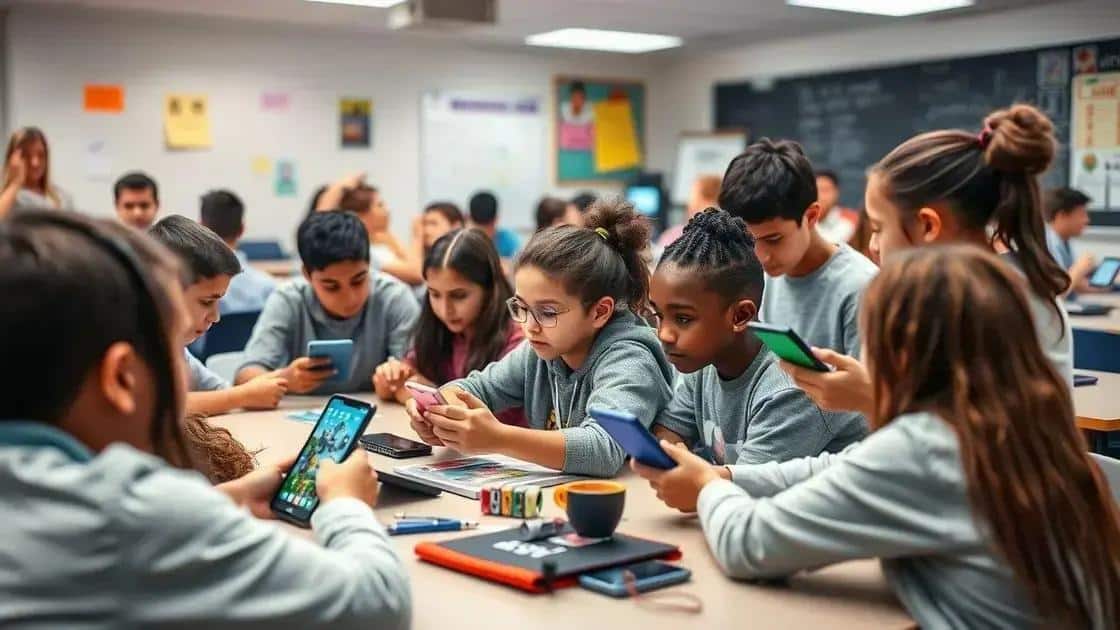Gamified learning platforms insights to enhance education

Gamified learning platforms enhance education by using game mechanics to increase student engagement, improve retention, and create interactive learning experiences through tools like Kahoot! and Duolingo.
Gamified learning platforms insights are reshaping educational experiences, making learning more interactive and fun. Have you ever thought about how gamification can change the way we retain information?
Understanding gamified learning platforms
Understanding gamified learning platforms is essential for educators and students alike. These platforms utilize game elements to make learning more enjoyable and effective. By integrating points, badges, and challenges, learners stay engaged and motivated.
What are gamified learning platforms?
Gamified learning platforms are educational tools that incorporate game-like features into the learning process. They transform traditional lessons into interactive experiences. This approach not only boosts engagement but also improves knowledge retention.
Key features of gamified platforms
- Progress tracking: Users can monitor their achievements and learning progress.
- Interactive challenges: Engaging tasks keep learners motivated.
- Rewards systems: Badges, points, and leaderboards encourage competition and participation.
These features create a sense of accomplishment. As learners complete activities, they earn rewards that motivate them to continue. This method creates a dynamic atmosphere where learning feels less like a chore and more like a game.
Integrating game mechanics into education also allows for personalization. Students can learn at their own pace, revisiting challenging content as needed. This adaptability makes learning more accessible and tailored to individual needs.
Popular examples of gamified learning platforms
Some well-known platforms include Kahoot, Duolingo, and Classcraft. Each of these offers unique features that cater to different learning environments. For instance, Kahoot promotes competition in quizzes, while Duolingo focuses on language learning through fun challenges.
By embracing gamified learning platforms, educators can create a rich, engaging environment. These platforms not only enhance learning outcomes but also foster a love for education among students.
Key benefits of gamification in education

The key benefits of gamification in education are numerous and impactful. Gamification enhances the learning experience by making it more engaging and interactive. Students are more likely to participate when they feel like they are playing a game.
Increased engagement
One of the main advantages is increased student engagement. When lessons include game elements, students are motivated to learn. They participate eagerly and invest more time in their studies. This active participation helps them grasp concepts better than traditional methods.
Improved retention
Gamification also significantly improves information retention. When students interact with material in an enjoyable way, they tend to remember it longer. Learning becomes a memorable experience, rather than a mundane task.
- Interactive challenges: Students face challenges that encourage critical thinking.
- Real-time feedback: Immediate responses help learners understand their mistakes.
- Visual rewards: Badges and points provide motivation.
Another benefit is the instant feedback students receive while playing. This feature allows them to learn from their mistakes as they progress. It acts as a personal coach, guiding them through the learning process.
Moreover, gamification promotes healthy competition among peers. When students see others achieving points or badges, they naturally strive to improve their performance. This fosters a supportive learning environment where everyone supports one another to achieve their goals.
Enhanced collaboration
Collaborative games encourage teamwork. Students can work together to solve problems and achieve learning objectives. This collaboration builds social skills that are crucial for future success.
By integrating gamification into education, educators can provide a richer learning experience. These benefits can lead to better academic performance and a more positive attitude towards learning.
How to choose the right gamified platform
Choosing the right gamified platform is crucial for enhancing the learning experience. With many options available, it’s important to consider a few key factors to ensure the platform meets the needs of both educators and students.
Identify learning objectives
First, identify your learning objectives. What do you hope to achieve through gamification? Knowing your goals will help you choose a platform that aligns with your educational needs. Whether you want to increase engagement, improve retention, or foster collaboration, setting clear objectives is essential.
Consider user experience
User experience is another vital aspect. A platform should be intuitive and easy to navigate. Students are more likely to use a platform that they find enjoyable and user-friendly. Look for platforms that offer engaging designs and straightforward features.
- Interactive elements: Check for features like quizzes, challenges, and leaderboards.
- Customization options: Ensure educators can tailor the platform to fit their teaching style.
- Accessibility: The platform should be accessible to all students, regardless of their skill levels.
Additionally, evaluate the types of gamified activities offered. Different platforms provide varying game mechanics that can enhance the learning process. Look for options that offer a mix of individual and collaborative activities to support diverse learning styles.
Another important factor is feedback mechanisms. A good gamified platform should provide instant feedback, allowing students to understand their progress and areas for improvement. This feature helps keep students motivated throughout the learning process.
Research platform reviews
Finally, don’t forget to research reviews and testimonials from other educators. Feedback from users can provide valuable insights into how effective a platform is in achieving its goals. Look for case studies or success stories that demonstrate the platform’s impact in real classrooms.
In summary, when choosing the right gamified platform, consider your learning objectives, user experience, types of activities, feedback mechanisms, and user reviews. By carefully evaluating these factors, you can select a platform that enhances learning and keeps students engaged.
Examples of successful gamified educational tools

Many successful gamified educational tools have transformed how students learn. These platforms utilize game mechanics to create engaging learning experiences. Here are some noteworthy examples that demonstrate how gamification can enhance education.
Kahoot!
Kahoot! is one of the most popular gamified tools in classrooms. It allows teachers to create interactive quizzes that students can answer in real-time. This engaging platform encourages friendly competition while reinforcing knowledge. With visuals and music, Kahoot! makes learning fun and exciting.
Duolingo
Duolingo is a language-learning platform that uses gamification to help users learn languages. Students earn points for completing lessons and can track their progress on a leaderboard. The colorful visuals and interactive exercises keep learners motivated. Duolingo makes learning new languages enjoyable and accessible.
- PBL (Project Based Learning): Students work on real-world projects that enhance problem-solving skills.
- Classcraft: This tool turns education into a role-playing game where students gain points by contributing in class.
- Quizizz: Another quiz-based platform that provides instant feedback and allows for self-paced learning.
Additionally, Project Based Learning (PBL) incorporates gamified elements by allowing students to engage in real-world projects. This active learning approach helps students apply their knowledge in practical situations.
Classcraft is an innovative platform that turns classroom experiences into a role-playing game. Students earn points for good behavior and participation, which motivates them to stay engaged and work together.
Quizizz
Quizizz allows students to take quizzes at their own pace while competing against peers. The platform offers instant feedback, making it easier for students to understand their mistakes. This tool encourages a fun learning atmosphere, where students feel less pressure.
These examples highlight how gamified educational tools can revolutionize learning. By incorporating game elements, educators can create more engaging, effective, and enjoyable experiences for students.
FAQ – Frequently Asked Questions about Gamified Learning Platforms
What are gamified learning platforms?
Gamified learning platforms are educational tools that use game mechanics to enhance engagement and motivation among students.
How do gamified tools improve student retention?
These tools create interactive experiences that make learning enjoyable, helping students remember information better.
Can gamification be used in any subject?
Yes, gamification can be integrated into various subjects, from math and science to language learning and arts, making it versatile.
What are some examples of successful gamified educational tools?
Some popular examples include Kahoot!, Duolingo, and Classcraft, each offering unique approaches to gamified learning.





